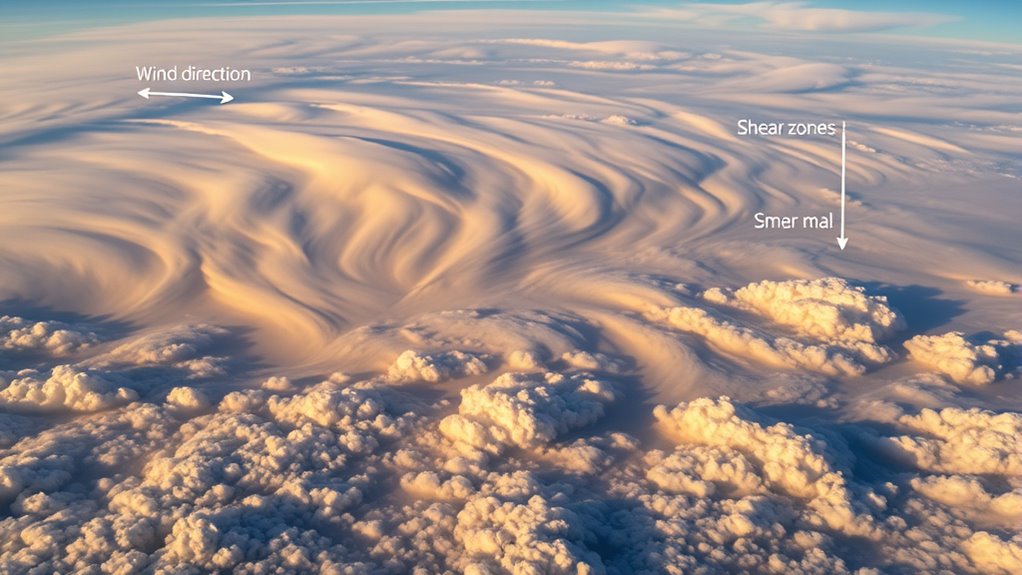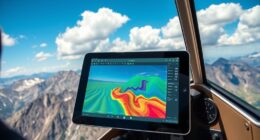Wind direction changes with altitude are mainly caused by layers within the atmosphere, like the boundary layer and upper-level jet streams. Near the surface, heating and cooling create turbulence and stabilize or destabilize winds, while at higher altitudes, fast-moving jet streams can cause sudden shifts—called wind shear. These variations impact weather, aviation, and pollution dispersion. Understanding how thermal effects and jet streams influence wind patterns helps explain why directions change as you go higher. Keep exploring to discover more about these atmospheric dynamics.
Key Takeaways
- Wind direction shifts with altitude due to boundary layer effects, thermal gradients, and influences from atmospheric layers like jet streams.
- Wind shear results from rapid changes in wind speed or direction across different altitudes, impacting weather and aviation safety.
- Thermal marking creates pressure gradients that cause varying wind directions at different heights, driven by temperature differences.
- Near the surface, daytime heating causes turbulence and wind variability, while nighttime inversions stabilize wind patterns aloft.
- Upper-level phenomena, such as jet streams, significantly influence high-altitude wind direction changes and shear patterns.

Wind direction often shifts as you move higher into the atmosphere, influenced by various atmospheric layers and geographic features. This variation is especially noticeable in the boundary layer, which extends from the Earth’s surface to about 1 to 2 kilometers up. Here, boundary layer dynamics play a vital role in shaping wind patterns. During the day, the sun heats the ground unevenly, causing the air close to the surface to warm and rise, creating thermals and turbulence. As the surface cools at night, temperature inversions can form, stabilizing the boundary layer and reducing wind variability. These shifts in wind direction are essential for understanding local weather, aviation, and even the dispersal of pollutants. Additionally, wind shear—a sudden change in wind speed or direction over a short distance—often results from the interactions within the boundary layer and upper-level jet streams, further complicating wind patterns at different altitudes. As you ascend beyond the boundary layer, the influence of surface features diminishes, and larger-scale atmospheric phenomena take over. One of the most significant influences at higher altitudes is the jet stream—fast-moving, narrow bands of high-altitude winds that meander across latitudes. Jet stream fluctuations can cause rapid changes in wind direction, affecting weather systems worldwide. These fluctuations occur due to temperature contrasts between air masses and the Earth’s rotation, leading to shifts in the jet stream’s position and strength. When the jet stream shifts, it can steer storm systems, alter precipitation patterns, and impact aviation routes. Thermal marking, which involves temperature differences across regions, also contributes to changes in wind direction with altitude. Warm and cold air masses create pressure gradients that drive winds at various levels. These gradients can be intensified or weakened by boundary layer dynamics and jet stream movements, resulting in complex wind shear patterns. Wind shear—a key concept here—is a sudden change in wind speed or direction over a short distance and is often linked to the interaction between boundary layer processes and upper-level jet streams. For instance, as a jet stream fluctuates, it can produce significant wind shear at different altitudes, which pilots and meteorologists closely monitor for safety and forecasting. Moreover, vertical wind shear can significantly influence storm development and intensity, making understanding these factors crucial for weather prediction.
Frequently Asked Questions
How Do Wind Shear Patterns Influence Aviation Safety?
Wind shear patterns considerably impact aviation safety by causing sudden turbulence, which can catch pilots off guard. You need to rely on turbulence prediction tools and stay updated with pilot training to recognize shear zones early. By understanding these patterns, you can adjust your approach, avoid hazardous areas, and ensure smoother flights. Proper awareness of wind shear helps prevent accidents and enhances overall safety during takeoff and landing.
What Tools Are Used to Measure Wind Direction Changes at Different Altitudes?
You use tools like Doppler radar and LIDAR wind profiling to measure wind direction changes at different altitudes. Doppler radar detects velocity shifts in the wind, providing real-time data, while LIDAR uses laser pulses to profile wind patterns vertically. These tools help you assess wind shear and thermal effects, ensuring safer flight planning and better understanding of atmospheric conditions. Both are essential in modern meteorological and aviation operations.
How Does Terrain Affect Wind Shear and Thermal Marking?
Think of terrain as nature’s sculptor, shaping wind patterns like a master artist. Terrain effects create obstacles and channels that influence wind shear, causing sudden changes in wind speed or direction. Thermal influences are amplified by features like mountains or valleys, which trap or channel heat, intensifying thermal markings. These terrain features directly impact how wind behaves aloft, making understanding terrain effects essential for predicting wind shear and thermal activity.
Can Wind Direction Changes Impact Weather Forecasting Accuracy?
Yes, wind direction changes can impact weather forecasting accuracy. When you rely on satellite imagery and atmospheric modeling, shifts in wind patterns can cause forecast errors if not properly accounted for. These variations influence cloud formation, temperature, and precipitation predictions. By accurately analyzing wind direction changes, especially at different altitudes, you improve the precision of forecasts, helping you better anticipate weather events and make informed decisions.
How Do Wind Shear and Thermal Marking Vary Across Different Climate Zones?
In tropical zones, wind shear can reach speeds of over 50 knots, creating intense thermal markings that influence weather systems. In contrast, polar regions experience minimal shear, with more stable wind patterns. These climate zone variations shape regional wind patterns, affecting weather forecasting and climate behavior. Understanding these differences helps you predict storms and climate impacts more accurately, especially in areas prone to severe weather driven by shear and thermal effects.
Conclusion
So, as you stand there and watch the wind shift with altitude, you realize it’s like a secret dance of nature, constantly changing and surprising you. Wind shear and thermal effects shape the atmosphere’s story, reminding you that even in this modern age, the skies hold mysteries as old as the time of knights and castles. Keep exploring, and you’ll uncover more of these fascinating patterns—nature’s own medieval tapestry woven high above your head.








